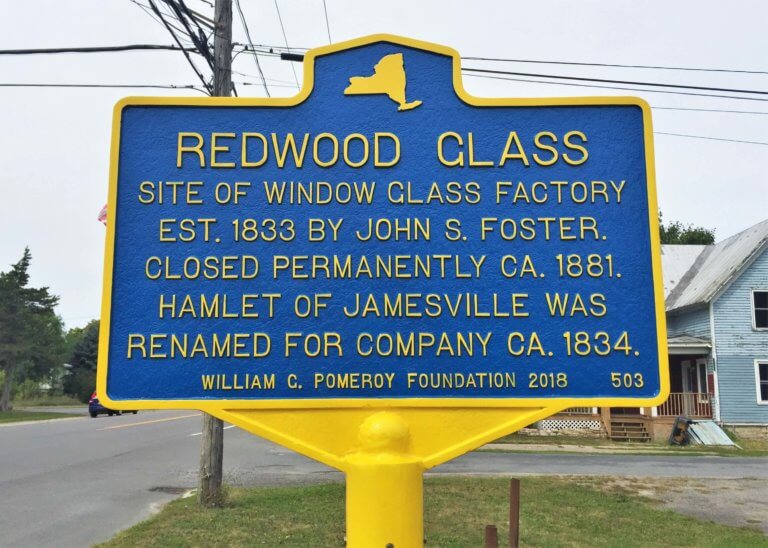REDWOOD GLASS
- Program
- Subject
- Location
- Lat/Long
- Grant Recipient
-
NYS Historic
-
Industry & Commerce, Site
- 43694 NY-37, Redwood, NY 13679, USA
- 44.3009214, -75.8012756
-
Redwood Historical Society
REDWOOD GLASS
Inscription
REDWOOD GLASSSITE OF WINDOW GLASS FACTORY
EST. 1833 BY JOHN S. FOSTER.
CLOSED PERMANENTLY CA. 1881.
HAMLET OF JAMESVILLE WAS
RENAMED FOR COMPANY CA. 1834.
WILLIAM G. POMEROY FOUNDATION 2018
Prior to 1833, the hamlet of Jamesville, in the Town of Alexandria, New York, had a population of around 100 residents and was connected to “the outside world only by a road from Alexandria Bay to Theresa” ((“Redwood Glass: The Story of Jefferson County Factory,” The Quarterly SLCHA, John Baule, 1978). This was all to change when a man named John S. Foster visited Jefferson County for the first time in April of 1833 (John Foster Appointments of US Postmasters, National Archives).
John Foster was familiar with the glass business, having worked in factories in Boston, MA, Burlington, VT and Redford, NY (History of Jefferson County, New York, Samuel W. Durant, and Henry B. Peirce, 1878). He was scouting a location to start his own glass factory after being what he considered “unjustly discharged” from the factory in Redford (“Redwood Glass: The Story of Jefferson County Factory”). Foster chose Jamesville due to the local stream which connected two neighboring lakes: Mud and Butterfield. This stream allowed for a supply of water to power the factory. He was also looking for deposits of sandstone and limestone nearby along with an abundance of wood for fuel Redford (“Redwood Glass: The Story of Jefferson County Factory”). Jamesville met these three conditions nicely. To acquire the necessary land for his glass factory, Foster contracted with Francis Depau, a French landowner, for 10,000 acres of land and borrowed thousands of dollars from Depau as well. After purchasing the property, Foster built a factory, a kiln, a blast furnace, an office building, a pounding mill and a box factory.
In order to compete with his former employer and now rival Redford, Foster changed the name of the hamlet from Jamesville to similar sounding Redwood (“Redwood Glass: The Story of Jefferson County Factory”). On September 30, 1833, the first glass was produced (St. Lawrence Republican, 18 Feb 1834). The factory was known for making glass for windows, however it is “best remembered by avid collectors for the fancy and rare decorative pieces – bowls, paperweights, canes” made by the glass workers in their spare time (“Redwood Glass: The Story of Jefferson County Factory”). . Usually these pieces also had an aquamarine tint due to Foster’s original formula for mixing the ingredients.
After three months of production, operations ceased with the sudden death of John Foster in January 1834 (“Redwood Glass: The Story of Jefferson County Factory”). Depau was given the factory as a result of Foster’s debt owed to him. However, having recently retired to France, Depau had no interest in running the factory. After Foster’s death the glass company changed hands several times.
In 1844, DeZang and Co. took over until July 1, 1853, during this time they established a joint stock company with $12,000 in capital (“Redwood Glass: The Story of Jefferson County Factory”). This company was known as “Redwood Glass-Manufacturing Company.” In 1859, a man named W.W. Butterfield became president of the company and remained the president until 1863. During those four years, Butterfield managed to purchase the entire company stock and subsequently became the sole owner.
As the years progressed, Butterfield leased the factory to a stock company. Unfortunately in the late 1860s tragedy struck when a fire destroyed the factory. While the cause of the fire is unknown, it was believed that dry wood was kept too close to the pottery room and was therefore to blame for the blaze (“Redwood Glass: The Story of Jefferson County Factory”). In 1872, The Daily Journal announced that the factory was “being rebuilt on a larger scale than before, and will go into operation early July.” It also stated the factory was to have a larger staff, a saw mill and a store. The economy was booming for glass and making it became cheaper with the introduction of coal to burn rather than wood. Also, a railroad was built in 1875 to connect Redwood with Alexandria Bay, further aiding the transportation of products and increasing commerce. In 1880, Butterfield opened his new factory.
In 1881, the glass industry proved to be too challenging for Butterfield to compete. Due to Redwood’s isolated location, the high cost of transporting materials to the factory made it difficult to be profitable and it could not keep up with glass factories that were closer to necessary resources. The factory permanently closed in the summer of 1881. The factory building was torn down for timber in 1895 (“Redwood Glass: The Story of Jefferson County Factory”). Even though Redwood Glass eventually shuttered, it attracted people to settle in the area and contributed to the development and growth of other local businesses.

